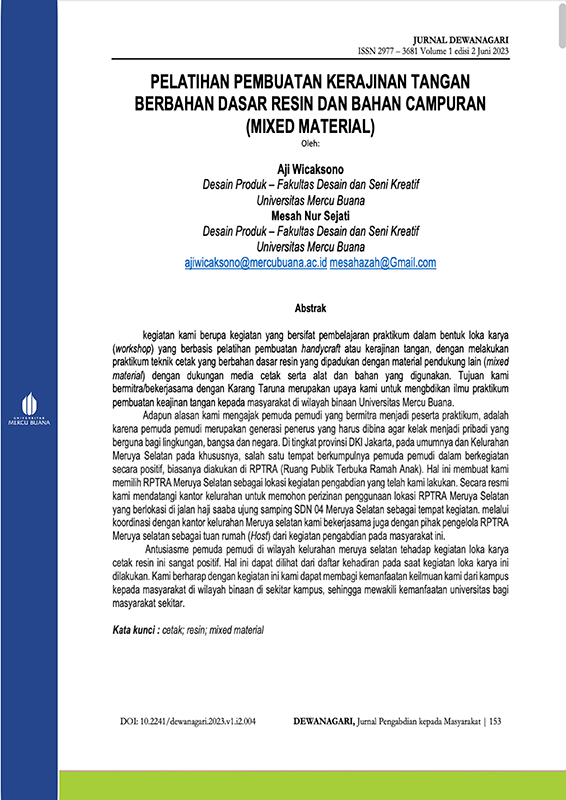
PELATIHAN PEMBUATAN KERAJINAN TANGAN BERBAHAN DASAR RESIN DAN BAHAN CAMPURAN (MIXED MATERIAL)
Abstract
Our activities are in the form of practicum learning activities in the form of workshops based on training in making handicrafts, by conducting practical printing techniques made from resin combined with other supporting materials (mixed material) with the support of print media and tools and materials used. Our goal in partnering/collaborating with youth social society (Karang Taruna) is our effort to provide practical knowledge of making handicrafts to the community in the mentoring area of Mercu Buana University.
The reason we invite young people to become our partners as the practicum participants is because young people are the next generation who must be nurtured so that in the future they will become useful individuals for the environment, nation and state. At the provincial level of DKI Jakarta, in general and Kelurahan Meruya Selatan in particular, one of the places where young people gather for positive activities, usually held in RPTRA (Child-Friendly Open Public Space). This made us choose the Meruya Selatan RPTRA as the location for our community service activities. We officially went to the sub-district office to ask for permission to use the Meruya Selatan RPTRA location which is located on Jalan Haji Saaba at the end of SDN 04 Meruya Selatan as a place for activities. Through coordination with the Meruya Selatan sub-district office, we are also working with the management of the Meruya Selatan RPTRA as the host of this community service activity.
The enthusiasm of young people in the Meruya Selatan sub-district area for the resin printing workshop was very positive. This can be seen from the list of attendance at the time the workshop was conducted. We hope that with this activity we can share the benefits of our knowledge from the campus to the community in the mentoring area around the campus, so that it represents the benefits of the university for the surrounding community.
Full Text:
PDFReferences
A Pizzi. 2003. “Unsaturated Polymer Adhesive”. France. Ecole Nationale Superieure des Technologies et industries du bois: Universite de Nancy I.
Cao, Xia dan L James Lee. 2002. “Control of Shrinkage and Residual styrene of Unsaturated Polyester Resins Cured at Low Temperatures : I. Effect of Curing Agents”. Colombus. Departement of Chemical Engineering: The Ohio State University.
Chandra , Manas dan Salil K Roy. 2009. Industrial polymers, Specialty Polymers, and Their Application “Plastic Engineering Series”. Boca Raton: CRC Press.
Dholakiya, Bharat. 2012. “Unsaturated Polyester Resin for Special Application”, Gujarat. Chemistry Departement: Sardar Vallabhai National Institute of Technology.
Ellis, Bryan (Ed.). 1993. “Chemistry and Technology of Epoxy Resins”. United Kingdom : Springer-Science+Business Media, B.V.
K.P Unnikrishnan. 2006. “Studies On The Toughening Of Epoxy Resins”. Kochi. Departement Of Polymer Science And Rubber Technology: Cochin University Of Science And Technology.
Loyal Enterprise Co. “ Lycal Resins Catalogue” . Kwai Fung Crescent. Kwai Chung.
Margono S. 2007. Metologi Penelitian Pendidikan Komponen MKDK. PT. Rineka Cipta, Jakarta.
R&G Faserverbundwerkstoffe GmbH. 2016. “UP cast resin, transparent”. Waldenbuch. Germany.
Riduwan. 2004. metode Riset. PT. Rineka Cipta, Jakarta.
Salomon, G. dan Schonlau. 1951. Rubbery Adhesive. In de Bruyne, N. A. and R. Houwink.Adhesion and Adhesive. Elsevier Publishing Company, Amsterdam. 386-485.
Refbacks
- There are currently no refbacks.
Jurnal DEWANAGARI : Jurnal Pengabdian kepada Masyarakat (PkM) Desain dan Seni
Fakultas Desain dan Seni Kreatif
Universitas Mercu Buana
Gedung C Lantai 2
Jl. Raya Meruya Selatan no.1, Kembangan, Jakarta 11650
Tlp./Fax: +62215871335
Journal International Standard Serial Number (ISSN) Registration:
Tools for Citations & Plagiarism Detection:

Ciptaan disebarluaskan di bawah Lisensi Creative Commons Atribusi-NonKomersial 4.0 Internasional









